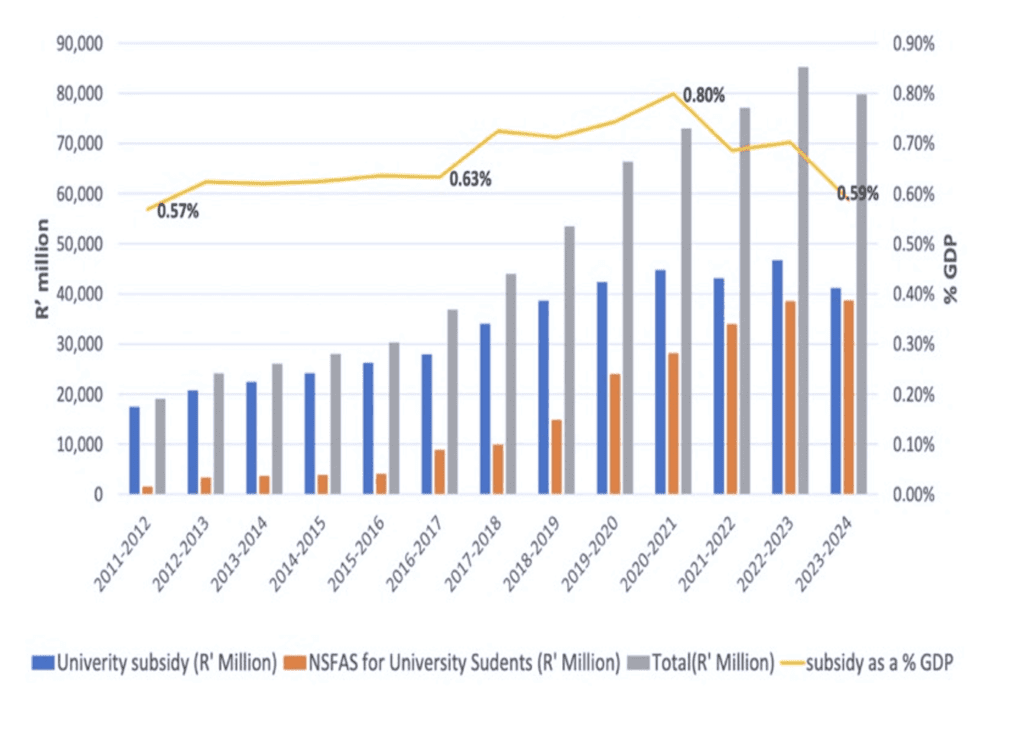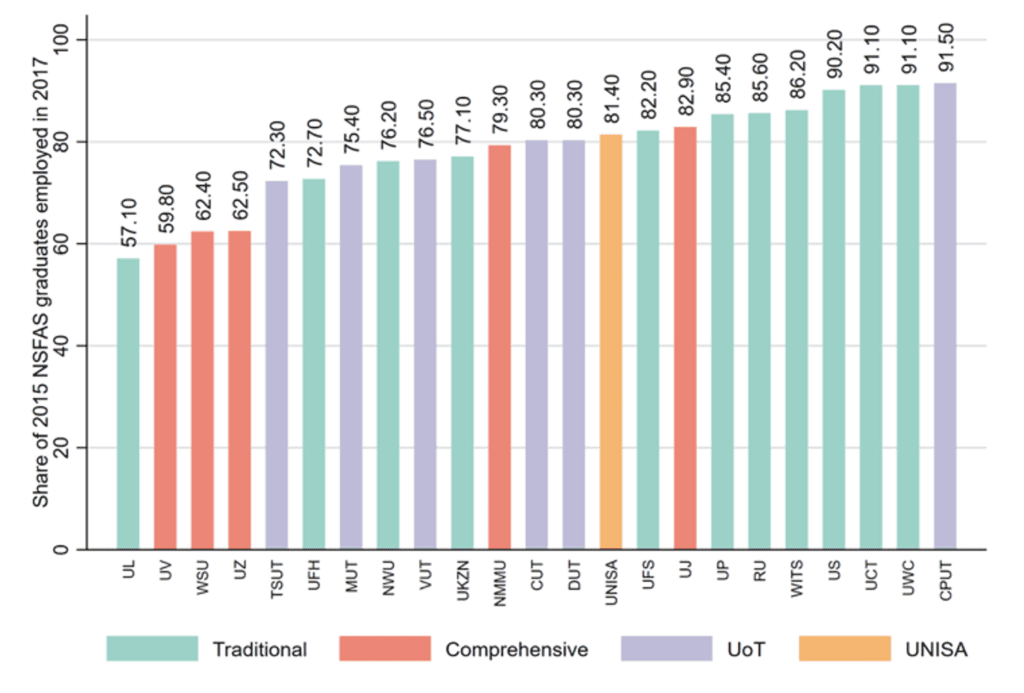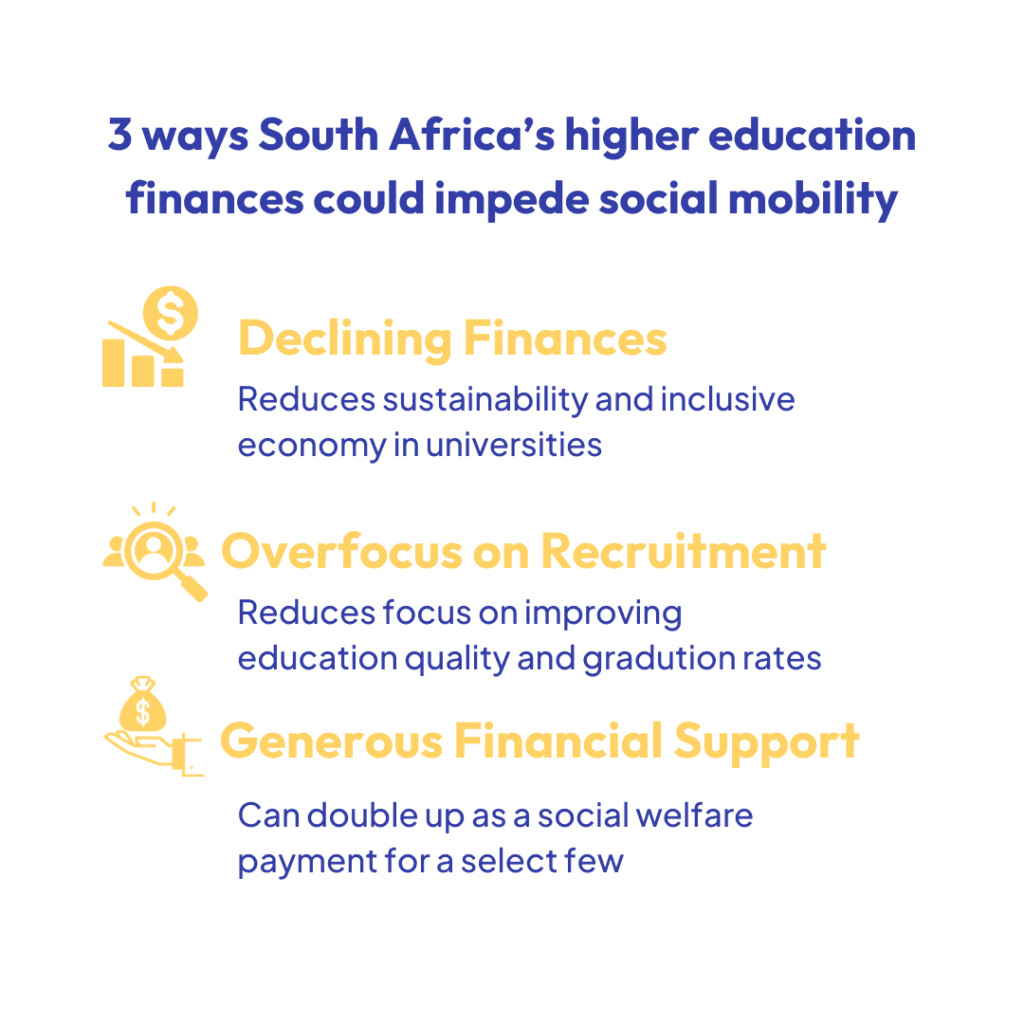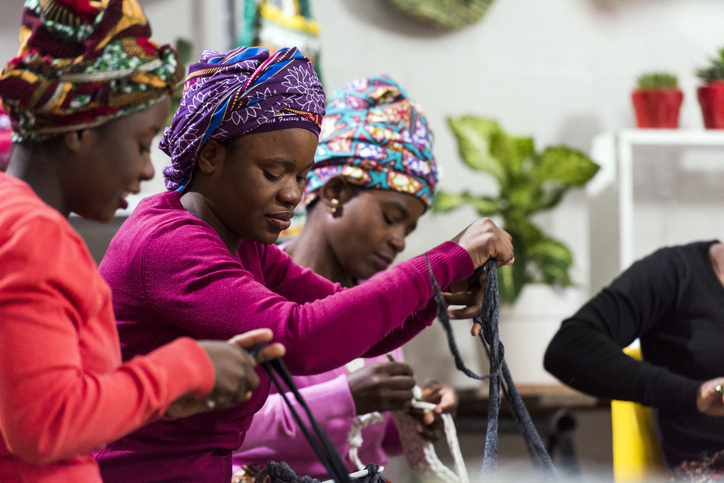By supporting social mobility, higher education can help economies become more socially inclusive. However, South Africa’s generous financial aid scheme for higher education could risk constraining the sector’s social and economic potential. This column explores what evidence is available.
Higher education can advance inclusive development and foster a transformed society. To help overcome entrenched inequalities in South Africa, the government provides financial support to students for whom university would otherwise be unaffordable. This support offers students access to higher education – and all the economic benefits it brings for both the individual and society at large.
The financial aid system has undergone recent changes that bring a new set of complex but critical considerations. This article explores these potential issues that could change students’ incentives for going to university, as well as universities’ incentives to improve student performance and graduation rates. These changes have the potential to impede social mobility and inclusive development.
We identify a lack of evidence about whether the current funding system is (cost-) effectively promoting upward mobility. To fill this gap, we suggest that data that tracks students from university entrance to employment is necessary to inform decisions that can ensure higher education fulfils its social and economic potential.
How is higher education funded in South Africa?
Universities in South Africa receive direct government funding through subsidies that are linked to research, student enrolment and student graduation rates. They also receive funds indirectly through the tuition and accommodation fees of students at the university who are supported by the government’s National Student Financial Aid Scheme (NSFAS). This program enables students to attend university by fully covering their tuition and accommodation fees. Students also receive allowances for living and transport expenses, as well as study materials.
Until recently, universities received much more money through direct subsidies than indirectly through NSFAS. Following a costly and contentious expansion of NSFAS in 2018, however, universities now receive roughly the same amount from both sources, with total funding showing a decline in 2023 (see Figure 1).
A shift in funding sources, towards NSFAS and away from subsidies, may not be problematic if total finances to institutions were to remain unchanged. In reality, however, it introduces two potential ramifications. The first relates to the fact that around a quarter of the total NSFAS allocation shown in Figure 1 goes directly to students through allowances (own estimate for 2019), rather than to institutions. With constrained budgetary resources, this shift could reduce institutions’ income and affect their ability to function sustainably.
Figure 1: Nominal growth in funding for universities and students (2011–2023)

Source: University State Budgets – Public Report; DHET March 2023 in presentation by Diane Parker and Thandi Lewin, SAAIR 2023.
The second ramification is that the changing structure of funding could potentially shift universities’ focus towards enrolling more students, to capture funding from tuition and accommodation fees, and reduce emphasis on improving student performance and graduation rates. This could have profound consequences for upward mobility. University graduates have much better chances of securing well-paid work in South Africa than non-graduates (including those who drop out of university).
Social spending for social mobility?
South Africa offers social welfare payments for children and older adults, but there is a gap in protection for the working age population. Unemployment rates are high among this group, and especially among younger adults (34.3% of people aged 15–24 were not in Employment, Education or Training in Quarter 2 of 2023).
NSFAS acts as a form of social protection for members of this age group who attend post-secondary education. For example, NSFAS continued to provide allowances to students who remained enrolled during the COVID-19 pandemic. At 1500 Rand (R) per month, this likely represented an important source of income to students’ households. Anecdotal evidence suggests that, like other social grants, NSFAS allowances are shared with students’ families. As a value comparison, the Social Relief of Distress Grant, introduced during the pandemic, is just R350 per month – although it reaches many more people.
If viewed in this way, NSFAS is an expensive ‘social protection mechanism’ available to the very select few who can access higher education. Nonetheless, NSFAS expenditure growth is projected to be 11% for 2019–2024), exceeding growth in university subsidies (3.9%), inflation (5%), social grant expenditure (6%), and basic education (2.5%).
Projected rises in enrolments and increasing demand for NSFAS mean that it is more important than ever for policymakers to understand the returns to NSFAS, and the cost-effectiveness of these large government investments.
Two further, essential considerations arise. Does the potential for upward mobility and the consequent social and economic gains justify the growth in NSFAS in our current financially strained environment? Furthermore, will the way in which funding is currently being apportioned, especially under the current NSFAS policy, lead to the desired graduation and labour market benefits?
Figure 2: Labour market absorption for 2015 NSFAS graduates, disaggregated by institution

Source: Adapted from Wildschut et al. (2020). Transformation, stratification and higher education: exploring the absorption into employment of public financial aid beneficiaries across the South African higher education system.
Is NSFAS (cost-) effective?
Evidence on graduate destinations is limited in South Africa. An exception is a study that matches tax data and NSFAS students who graduated under the previous NSFAS model. The incentive structure was different under the previous scheme and updated evidence is urgently required, but the study does show how important data is for understanding the impact of the sector on social mobility. For example, Figure 2 shows that among the 2015 cohort of NSFAS-funded graduates, positively, over half were in formal sector employment in 2017. That said, institutions with the highest share of NSFAS students face some of the lowest employment prospects. Relatedly, dropout among NSFAS students is high in some of the institutions with better employment rates.
On the one hand, dropout by students who are unlikely to graduate can be viewed, purely from a budgetary perspective, as a good thing for public coffers. On the other hand, NSFAS could shift the costs vs. benefits of enrolling in university because it offers social protection against a backdrop of high unemployment. In other words, does NSFAS make poorer students more likely to enrol in university, and potentially into programs not aligned with the skills needs of the economy – even if they know they may not graduate?
Another intricacy that policymakers would do well to consider, however, is dropout among students who are likely to succeed but cannot continue their studies because they have reached their maximum number of years of funding. They represent a substantial public investment and impede the sector’s ability to foster upward mobility, at a substantial cost.

A call for evidence
Policymakers face contention between the supportive role of NSFAS, and its possible distortionary effects on student and university performance. Universities face shrinking subsidies, alongside pressures to ensure student success and employability. Ultimately, a better understanding of whether the current funding system is (cost-) effectively promoting upward mobility crucially requires comprehensive monitoring of system-wide student success – from the day they enrol through to their graduation and employment. This data exists in silos but is not (yet) linked in the way that is urgently needed to inform decision making.
What’s more, this evidence can be used to help universities collaborate with each other to save overall costs across the sector. This will be key as financial pressures rise. An example of this strategic collaboration already exists in the Siyaphumelela (`we succeed’) Network Initiative. This aims to expand evidence-based student success efforts by building on existing strengths, sharing capacity throughout the sector, and serving institutions based on their needs and abilities.
This article is published in collaboration with the International Economic Associations’ Women in Leadership in Economics initiative, which aims to enhance the role of women in economics through research, building partnerships, and amplifying voices.







